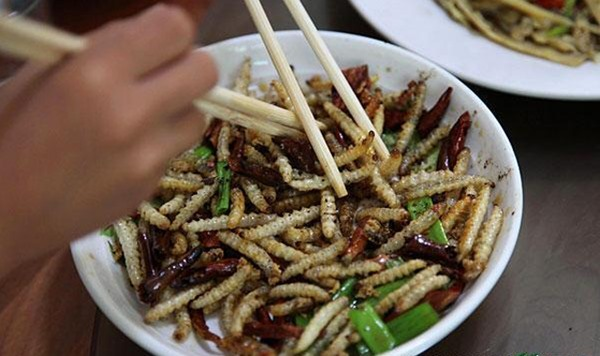Worming its way back to the culinary club
For the Dao Do (Red Dao) people in the northern province of Ha Giang or the Muong in the central province of Thanh Hoa, Sau tre (bamboo worm), once a staple, has become a rare treat.
 Stir-fried bamboo worms is a favourite dish for many people. (source: daikynguyenvn.com)
Stir-fried bamboo worms is a favourite dish for many people. (source: daikynguyenvn.com)Hanoi (VNA) - For the Dao Do (Red Dao) people in the northern province of Ha Giang or the Muong in the central province of Thanh Hoa, Sau tre (bamboo worm), once a staple, has become a rare treat.
Only elders in these two ethnic minority communities residing mostly in the northern and central provinces know how to collect the worm and make tasty dishes with it.
Once it is cooked, Sau tre takes on a golden colour. The worm looked like a chrysalis, somewhat smaller. Despite the eye-catching decoration and colour, many initially hesitate to taste the dish.
But once one summons sufficient courage to try it, one will take to it immediately. The worm is succulent, juicy, and the herbs used blend well with it.
There are different ways to cook Sau tre. It could be deep fried, steamed or braised, but the most popular dish was Sau tre stir fry.
The worms are washed and cleaned carefully, seasoned with salt and set aside for 15 minutes. Fat (lard or oil) is heated in a pan, and shallots as well as the worms are added to it. After stir-frying for about three minutes, when the worms taken on a light golden colour, finely chopped lime leaves are added. A quick stir-fry, and the dish is served immediately.
The mild scent of the bamboo, the strong flavour of Sau tre and the light bitterness of lime leaves make for a special, tasty dish perfect to enjoy on cold and humid days.
Sau tre was a special dish for mountainous communities. People began collecting them when they lived mostly of the land, and food became scarce.
As other food became more easily available in the market, the Sau tre was no longer a must. Young people soon forgot how to collect and cook it. Also, Sau tre requires a lot of ingredients, additives, and several steps are involved, from collecting it to preparing it and cooking it. It can even take more than a day to serve a Sau tre dish.
Finding Sau tre
The bamboo worm season normally lasts from September till the end of October, during which the worms are the fattest and give birth the most.
To collect Sau tre, a knife and a basket are the tools required. People look for dry and almost dead bamboo grass, chop them down then empty the stalks to get the worms inside. On a lucky day, one can get 1 to 1.5 kg of Sau tre. The worm is white and 3.5 to 4cm long.
In Vietnam, this special worm can be found in the northern mountainous provinces of Dien Bien, Lai Chau, Son La and Ha Giang or central provinces like Thanh Hoa and Thua Thien-Hue.
Even during the breeding season, it is not easy to get them, because not every bamboo section will carry them.
During its season, prices for this mountain specialty can go be up to half a million VND (23 USD) per kilo, but supply still fails to meet rising demand. People have to order about a week in advance to be served this dish.
Another factor that raises the price of bamboo worm is difficulties in transporting them.
“Delivering the bamboo worm alive is hard to do. And if they are not careful enough, the worms will die so the dishes will not be as tasty as expected,” said Le Van Tho, a Sau tre wholesaler. “Therefore, as soon as I gather enough of them, I do not wait. I get them straight to the customer, so they are fresh and my loss is reduced.”
But for those who have taken to them, all the trouble taken and the price are worth it.
“I have to order bamboo worms in Thanh Hoa Province one week earlier,” said Nguyen Hoang Quan, who lives on Hoang Hoa Tham Street in Hanoi. And he sometimes waits for two hours at the bus terminal to collect the delivery.
“My very first time, I felt creepy on seeing the worms on the table, but I fell in love with their crispy, aromatic and greasy taste after my first attempt.
“After just one bite, I wanted to have more and more, and have, unconsciously, become addicted to them.” — VNA













